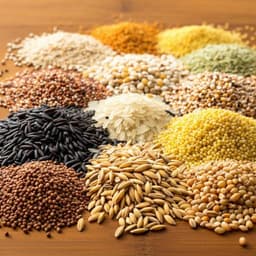
Agriculture
Water rights shape crop yield and revenue volatility tradeoffs for adaptation in snow-dependent systems
K. Malek, P. Reed, et al.
This study explores how climate change is transforming irrigated agriculture in the Yakima River Basin, revealing that droughts and rising temperatures threaten productivity. While new crop varieties might boost yields, they also heighten risks of water shortages and revenue volatility. Research conducted by Keyvan Malek, Patrick Reed, Jennifer Adam, Tina Karimi, and Michael Brady.
~3 min • Beginner • English
Introduction
The study addresses two core questions: (1) What are the direct (biophysical) and indirect (water availability and institutional) impacts of climate change on irrigated agriculture in the snow-dependent Yakima River Basin (YRB)? (2) To what extent can farmer adaptation via planting different (improved) crop varieties offset negative climate impacts? Contextually, irrigated agriculture—though practiced on ~20% of cultivated land—produces nearly 50% of global agricultural output and in many regions depends on snowpack-derived surface water. Warming is expected to reduce snowfall, diminish snowpack, and shift runoff timing away from the irrigation season, while elevated temperatures accelerate crop development and can reduce potential yields for key annual crops (e.g., corn, wheat, potatoes), even as elevated CO2 can partially offset water-stress effects. The YRB, a heavily irrigated, snowmelt-dependent basin in the U.S. Pacific Northwest, has complex water rights and limited reservoir buffering capacity, making it representative of broader snow-dominated systems. The study aims to quantify changes in expected mean yield and interannual yield variability under climate change, and to evaluate how improved, slower-maturing crop varieties affect both average productivity and the volatility of yields and revenues within the constraints of regional water rights and infrastructure.
Literature Review
Prior work shows global food demand growth and the critical role of irrigation in meeting it. Snow-dependent basins supply a substantial share of irrigation water, and warming-induced shifts from snow to rain and earlier snowmelt reduce summer water availability. Numerous studies document declining western U.S. snowpack and uncertain precipitation projections for the Pacific Northwest, highlighting temperature as the most robust change signal. Crop-climate literature indicates elevated CO2 can increase yields (especially for C3 crops), while higher temperatures generally shorten crop growth periods, reducing potential yields in major annual crops; multiple-cutting perennials like alfalfa can benefit from faster regrowth. There is active research on adaptation via improved, slower-maturing varieties, altered sowing dates, and breeding for heat tolerance, yet effectiveness is uncertain and constrained by breeding timelines and genetic limits. Many impact assessments lack explicit representation of managed reservoirs, water rights, and operational rules, potentially mischaracterizing water availability for irrigation. This study builds on and addresses those gaps by coupling detailed agro-hydrologic modeling with an institutional representation of YRB water rights.
Methodology
The study uses a physically based, coupled agro-hydrologic and river-system modeling platform linking VIC-CropSyst (for crop growth, land-surface hydrology, irrigation demand) with the YAK-RW (RiverWare-based) river system model (for reservoir operations and water allocation under YRB water rights). Spatial resolution is 1/16° across the YRB. Simulations cover a historical period (1980–2010) and future period (2030–2090). Climate inputs include daily minimum/maximum temperature, precipitation, and wind speed. Future climate is represented by five GCMs (GFDL-ESM2G, HadGEM2-ES365, HadGEM2-CC365, INMCM4, CanESM2) under RCP 4.5 and RCP 8.5, selected using Brekke et al. criteria; bias correction uses quantile mapping. Soil data derive from STATSGO; land cover and crop parameters (acreage, planting dates, irrigation systems, perennial/annual status, proration rates, root properties) are from prior VIC-CropSyst applications in the basin. Crop parameters (growth, transpiration, biomass, yield) follow Stockle et al., with additional assumptions for improved (slower-maturing) varieties described in Supplementary materials, including sensitivity analysis. The YRB setting includes five major dams storing ~30% of annual flow and a water rights system distinguishing proratable (subject to curtailment in drought) versus non-proratable rights. Drought severity is quantified using fraction of unmet demand (UD = 1 − water supply / water demand), computed consistently with YRB institutions and accounting for projected changes in irrigation demand. Outputs include annual yields (by crop), maximum (fully irrigated) and minimum (rainfed) yields, interannual yield variability (standard deviation of annual yield time series), and basin-wide UD distributions across GCMs/RCPs and future subperiods (2030–2060, 2060–2090).
Key Findings
- Water stress intensifies under climate change, driven primarily by temperature: UD increases with warming as snowpack declines and runoff timing shifts, with limited reservoir buffering (active capacity ~40% of total irrigation demand). Precipitation projections are uncertain and less influential than temperature.
- Probability and severity of droughts increase: The probability of significant drought (UD > 30%) rises from ~23% (1980–2010) to ~40% during 2030–2060 (range 13–63% across 5 GCMs × 2 RCPs). The average severity of significant droughts increases by about 6% relative to historical, with projected UD during significant droughts ranging ~34–47%. There is potential for unprecedented droughts (UD > 65%) and even years approaching UD = 100% in 2030–2060 and 2060–2090.
- Average yields decline across major crops due to more frequent/severe irrigation shortages and heat-driven shorter growing seasons. Examples:
• 2060–2090 (RCP 8.5): Potatoes −46%, Alfalfa −22%, Apple −48% (average annual yield vs. historical).
• 2030–2060 maximum (fully irrigated) yield reductions: Spring wheat −9%, Corn −23%, Potatoes −9%. Alfalfa maximum yield increases by +26% due to more cutting cycles.
• Minimum (no irrigation) yields increase: 2030–2060 Spring wheat +17%, Corn +25%, Potatoes +21% from higher CO2 and precipitation effects.
- Yield gap and marginal benefit of water (MBW): With status-quo varieties, smaller yield gaps emerge as maximum yields fall and minimum yields rise, implying reduced MBW for annual crops (e.g., yield gap reductions: Corn −45%, Potatoes −16%) and increased MBW for multiple-cutting crops (e.g., Alfalfa yield gap +11%).
- Interannual yield variability declines under status-quo varieties despite higher drought frequency, largely because potential yields drop for many crops:
• 2030–2060 SD of annual yield: Potatoes −15%, Corn −22%, Spring wheat −1%, Alfalfa −19%.
- Improved (slower-maturing) varieties increase mean yields but substantially raise interannual variability and risk of low-yield years:
• 2030–2060 average yield changes: Potatoes +14%, Spring wheat +20%, Corn +31%.
• 2030–2060 SD changes: Potatoes +52%, Spring wheat +130%, Corn +123%.
• Probability of low-yield years (<60% of fully irrigated yield) increases under both RCP4.5 and RCP8.5 for improved varieties.
- Insurance and revenue implications: Under status quo, lower interannual variability suggests reduced insurance premiums and payouts; under improved varieties, higher variability increases revenue volatility and likely premiums/subsidies, with altered yield–drought relationships affecting index-based insurance design.
- Transferability: Findings likely generalize to other snow-dominated irrigation systems where warming reduces snowpack and potential yields while institutional water rights constrain allocation.
Discussion
The study demonstrates that in snowmelt-dependent irrigation systems, climate warming creates a dual stressor: diminished, seasonally mismatched water availability and biophysical yield reductions from accelerated crop development. Within the YRB’s institutional framework prioritizing proratable and non-proratable water rights, these stressors reduce mean agricultural productivity. A key insight is that increased drought frequency does not necessarily translate into higher interannual yield variability for current varieties because the yield gap narrows (lower attainable maximum, higher rainfed minima). However, farmer adaptation via slower-maturing, higher-potential varieties reverses that pattern: mean yields can recover or increase, but vulnerability to irrigation shortages makes yields more volatile, increasing revenue risk. These outcomes directly address the research questions by quantifying direct (temperature/CO2) and indirect (water scarcity under rights and operations) impacts, and by clarifying that effective adaptation must jointly consider crop genetics and water governance/infrastructure. The significance extends to insurance and policy, indicating potential shifts in premiums, subsidies, and the performance of index-based products under nonstationary yield–drought relationships. The broader relevance to snow-dominated basins underscores the need for integrated water–agriculture adaptation planning.
Conclusion
Climate change is projected to substantially increase irrigation water stress and shorten growing seasons in the YRB, reducing average agricultural productivity across key crops. Despite more frequent/severe droughts, interannual yield variability decreases for status-quo varieties due to smaller yield gaps; thus, increased hydrologic uncertainty does not automatically imply greater annual revenue volatility. Improved, slower-maturing crop varieties can boost mean yields but markedly increase interannual yield variability and the probability of low-yield years, elevating revenue and insurance risks. Sustainable adaptation requires two concurrent strategies: (1) enhancing water availability and flexibility through infrastructure (storage, transfer) and institutional reforms (water rights/regulations) and (2) advancing crop breeding to improve potential productivity while managing variability under warmer, more water-limited conditions (e.g., leveraging agrobiodiversity, seed banks, IP frameworks, breeding under elevated temperatures, accelerating breeding cycles). Future research should refine heat-stress and irrigation-cooling representations at finer temporal scales, explore a broader suite of varietal strategies (including fast-maturing drought-escape types), and assess system-wide consequences of shifts in cropping patterns, locations, and irrigation technologies.
Limitations
- The study holds cropping patterns, agricultural geographic distribution, and irrigation systems constant; it does not simulate potential future shifts that could alter outcomes.
- No changes to water rights or regulations are modeled (e.g., no scenarios with relinquishment or institutional reforms).
- Crop heat stress is represented but crop mortality and irrigation-water-dependent cooling effects are not fully captured; more realistic heat-stress dynamics would require finer temporal resolution and coupled atmospheric–land–boundary layer modeling.
- Only one yield-improvement pathway (slower-maturing varieties) is considered; alternative strategies (e.g., shorter-duration drought-escape cultivars) are not explored and may entail different mean–variability tradeoffs.
- Projections inherit uncertainties from GCMs, downscaling/bias correction, crop parameterization, and water management assumptions; precipitation projections in the PNW are particularly uncertain.
Related Publications
Explore these studies to deepen your understanding of the subject.







